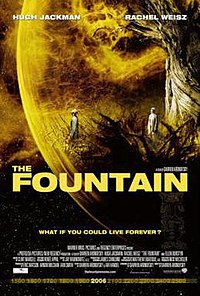The Fountain
These are some thoughts about The Fountain. If you haven't seen it yet then please stop reading.

We re-watched it two nights ago. I think it is my favourite film. Certainly in my top 3. Everyone seems to disagree on what it is about, which is a good thing.
It's a sci-fi film (unless you view certain scenes as allegorical) about a tormented man who discovers the fountain of youth (a tree) in South America and thus lives into the far future, forever haunted by memories. Filmed almost entirely without computer graphics, the space scenes (as in the poster above) are astonishingly beautiful. It is Darren Aronofsky's third film, after Pi and Requiem for a Dream.
Hugh Jackman (in the DVD extras interview) said he thought it was about the resolution (on a personal level) of yin-yang dichotomies such as between the Christian Bible's Tree of Life and Tree of Knowledge.
For me the film (much like The Matrix) is Buddhist in nature, and captures the ultimate realization that the state of being alive and of being conscious are both merely rearrangements of the atoms of the world, and thus illusory. The main character conquers death both on a personal level and in the real world.
Mnki suggested that the film represents what is common to all religions: the need for a comforting explanation of death. We talked about how religions have evolved with the times and adapted to keep their explanations relevant. Maybe Christianity, as one of the newer religions, has one of the least convincing explanations because it is so obviously a product of modern (two-thousand year old) thinking. She then said: "nobody fully accepts their religion intellectually" which is quite shocking and probably true.
I got a lot more out a second viewing. Much of the photography is heavily coded with colour: gold and white. Other imagery that appears throughout includes a star field (the hanging candles in Spain, the glass of the hospital door) and two lights on either side of the main character that mirror the film's Mayan nebula Xibalba. All of these visual references (and I really don't think I'm over-interpreting this) add to the film's growing sense of impending doom. It's one of those films where knowing what's going to happen can actually enhance its power.
I don't know what I came here to say, other than that I had to write this down. Hello.

We re-watched it two nights ago. I think it is my favourite film. Certainly in my top 3. Everyone seems to disagree on what it is about, which is a good thing.
It's a sci-fi film (unless you view certain scenes as allegorical) about a tormented man who discovers the fountain of youth (a tree) in South America and thus lives into the far future, forever haunted by memories. Filmed almost entirely without computer graphics, the space scenes (as in the poster above) are astonishingly beautiful. It is Darren Aronofsky's third film, after Pi and Requiem for a Dream.
Hugh Jackman (in the DVD extras interview) said he thought it was about the resolution (on a personal level) of yin-yang dichotomies such as between the Christian Bible's Tree of Life and Tree of Knowledge.
For me the film (much like The Matrix) is Buddhist in nature, and captures the ultimate realization that the state of being alive and of being conscious are both merely rearrangements of the atoms of the world, and thus illusory. The main character conquers death both on a personal level and in the real world.
Mnki suggested that the film represents what is common to all religions: the need for a comforting explanation of death. We talked about how religions have evolved with the times and adapted to keep their explanations relevant. Maybe Christianity, as one of the newer religions, has one of the least convincing explanations because it is so obviously a product of modern (two-thousand year old) thinking. She then said: "nobody fully accepts their religion intellectually" which is quite shocking and probably true.
I got a lot more out a second viewing. Much of the photography is heavily coded with colour: gold and white. Other imagery that appears throughout includes a star field (the hanging candles in Spain, the glass of the hospital door) and two lights on either side of the main character that mirror the film's Mayan nebula Xibalba. All of these visual references (and I really don't think I'm over-interpreting this) add to the film's growing sense of impending doom. It's one of those films where knowing what's going to happen can actually enhance its power.
I don't know what I came here to say, other than that I had to write this down. Hello.
This post was originally on LiveJournal.